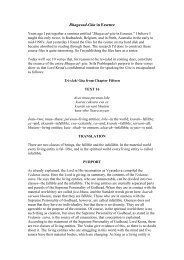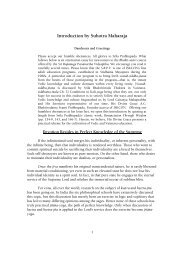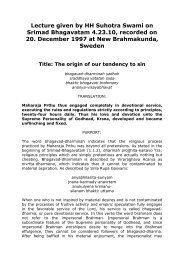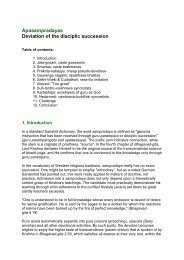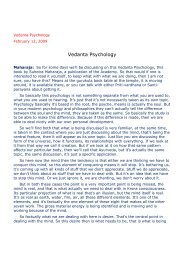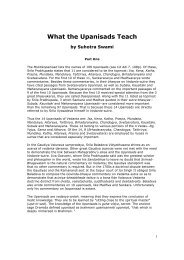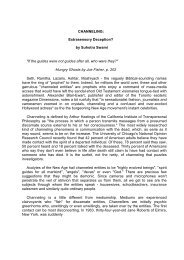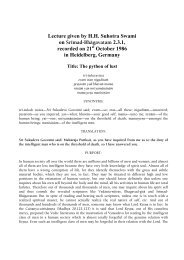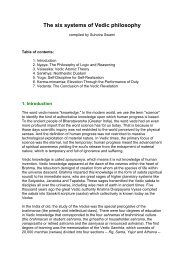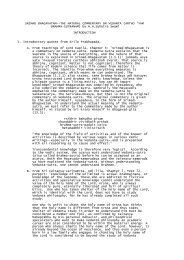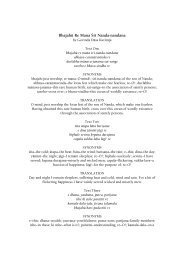Danda 1995 - Suhotra Maharaja Archives
Danda 1995 - Suhotra Maharaja Archives
Danda 1995 - Suhotra Maharaja Archives
- No tags were found...
You also want an ePaper? Increase the reach of your titles
YUMPU automatically turns print PDFs into web optimized ePapers that Google loves.
- From the context of the second quote it appears that the author is VaivasvataManu, which is also confirmed in 740218BG.BOM.- According to SB 8.1.16 and 710406LE.BOM itself the author is Svayambhuva Manu.2. To which extent are we supposed to follow it?In the first quoted purport SP says, "The conclusion is that if we want realpeace and order in the human society, we must follow the principles laid down bythe Manu-samhita and confirmed by the Supreme Personality of Godhead."On the other hand I heard that SP said to his grhastha disciples in Italy (whowanted to live according to M-s) that they will not be able to follow it becausethey are low-born. He also supposedly said that if we touch M-s we'll fall lowerthan mlecchas.Answer by <strong>Suhotra</strong> SwamiNovember 17, <strong>1995</strong>This is a hobby-question, isn't it? It doesn't make any difference to anyone'sKrsna consciousness, nor to the ISKCON mission, which Manu is the author of theManu-samhita.Svayambhuva Manu (who is also known as Manavacarya) is traditionally creditedwith authorship of Manusmrti. But since Manu is a post, not a specific person,and since the post is that of the "law-giver of mankind," it is not an unusualstate of affairs for the law be re-given or appended by a Manu after SvayambhuvaManu. Just like, though the Constitution of the US was written in 1789 by theso-called Founding Fathers like Thomas Jefferson and Benjamin Franklin, it wasamended by lawgivers of later generations. The amendment passed after the deathof Franklin Delano Roosevelt in 1945 limiting the president to twoterms inoffice was certainly not written by the Founding Fathers. But it is still partof the US Constitution.With a little bit practical knowledge, and applicative intelligence, thesehobby-questions answer themselves.Regarding your second question, Manusmrti is the dharma-sastra for Varnasramasociety. Nectar of Devotion is the dharma-sastra for ISKCON society. Nanasastra-vicaranaika-nipunausad-dharma-samsthapakau lokanam hita-karinau tribhuvanemanyau saranyakarau. These lines from Srisadgosvamyastakam answer yourquestion in full, but the short answer is that the Manusmrti principles arecontained in the NOD principles. Just like the principles of the Codes ofHammurabi are contained in modern European-American legal codes. Not in detail,but in spirit. To say in <strong>1995</strong> that "I don't care for modern codes of law, I willfollow the ancient Codes of Hammurabi" is the program of the knucklehead.PRAPATTIQuestion from Bhakta Jan MaresDecember 8, <strong>1995</strong>In the course about 4 sampradayas I've found following description:-------------Prapatti:Visistadvaita philosophy discusses besides Bhakti `prapatti' or absolute selfsurrender to God as an alternative means to `moksa'. Bhakti is a rigorousdiscipline, and for those, who are incapable of undertaking it, `prapatti' isadvocated as an alternative easy path to `moksa.' This doctrine is adopted onthe strength of the teachings contained in the Vedas as well as the Itihasas,Puranas, and Pancaratra literature.



